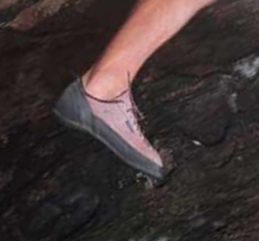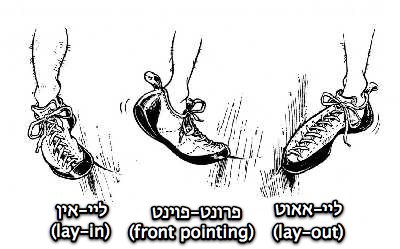Edging
Edging is a general name for a technique for using foot holds which are really small steps - edges. Edging is very different from smearing - the other major technique that uses mainly friction and allows the shoe to "stick to rounded and smoth holds.
Edging is basic and essential for face climbing and is also usefull on slightly overhanging faces.
When edging, the climber actually stands on a tiny step. Edges are very intuitive as footholds, especially if the hold is similar in size to your sole (not really edging, then). the smaller the edge is, the more you need to keep your foot horizontal' so it doesn't drop and loose traction. The key is to have the sole push perpendicukar to the surface of the hold. This ia also true for slightly sloping holds, even though it sometimes means leaning away from the rock and a little more load on your hands.
Often, edging can be more efficient when the inner side of your shoe is placed on the hold (rather than the point of your shoe) you might be able to get more contact area (along the edge, paralel to the rock face), bring your center of mass closer to the rock. This possition is more balanced and power efficient because more of your body weight can be placed above (or almost above) your feet.
A similar effect is achieved by using the outer side of your shoes. this is called lay-out. With very pointy shoes, one can edge by front pointing in small pockets or on tiny protruberances.
Different body possitions dictate Various foot placements. sometimes the slightest change in foot possition, like a small rotation or shift can make a huge difference.
אפקט דומה ניתן להשיג על ידי שימוש באחיזה בחלק החיצוני של כף הרגל (lay-out) ובנעלי טיפוס, בהן חלקה הקדמי של הסוליה הולך וצר, גם ע"י ה'שפיץ' של הנעל (front point). תנוחות גוף שונות מכתיבות צורות שימוש שונות בכף הרגל, וכדאי לנסות. לפעמים שינוי קטן כמו הזזה או סיבוב של כף הרגל על האחיזה משנים את כל ההרגשה והצעד הופך קל יותר.
Contributions to this page by: Micha Yaniv and others

